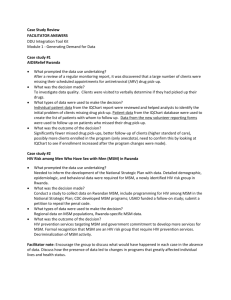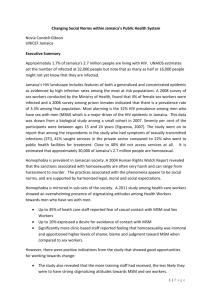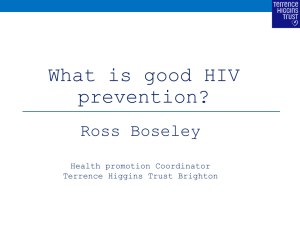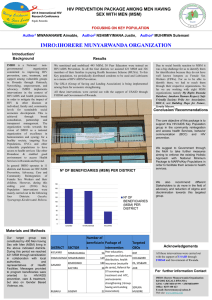Substance Abuse Treatment and HIV Services for youngSubstance
advertisement
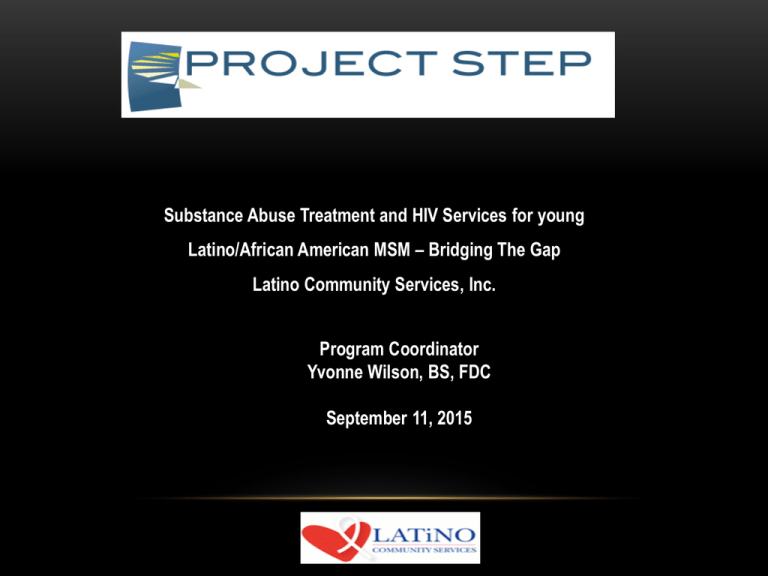
Substance Abuse Treatment and HIV Services for young Latino/African American MSM – Bridging The Gap Latino Community Services, Inc. Program Coordinator Yvonne Wilson, BS, FDC September 11, 2015 HIV AND AIDS AMONG LATINOS A Snapshot • Hispanics represent approximately 16 percent of the U.S. population, but account for an estimated 19 percent of people living with HIV (220,600 persons) and an estimated 21 percent of new infections (9,800) in the United States each year. • Men account for 87 percent of new infections among Hispanics. Estimated New HIV Infections among Hispanics, 2010, by Transmission Category MSM IDU Female 2% 8% Hetero female IDU MALE 7% 3% 12% 68% Hetero Male MSM-IDU MISSION To further reduce the spread of HIV/AIDS in the Latino community and other at-risk populations and improve the quality of life and health of people with HIV/AIDS. INTRODUCTION Latino Community Services Inc. (LCS), Project STEP is funded through a 5-year federal grant from SAMHSA’s Center for Substance Abuse Treatment (CSAT) for its Targeted Capacity Expansion Program for Substance Abuse Treatment and HIV/AIDS Services (TCE/HIV). Project STEP targets young Latino and Black men who have sex with men (MSM) who have received a primary diagnosis of substance abuse. The purpose of the project is to develop and enhance a system in which young MSM of color can access culturally competent and effective treatment and supportive services to reduce the impact of behavioral health problems and reduce HIV risk and incidence. PROJECT GOALS Project STEP targets young Latino and Black men who have sex with men (MSM) who have received a primary diagnosis of substance abuse. As described in the grant proposal, the goals of the project are to: • To provide evidence-based services over a period of 12 months to a total of 230 young MSM during the grant period (30 in year one, 50 per year in years two-five) • To expand system of culturally competent substance abuse, mental health, and other related services for young MSM of color. • To reduce HIV risk and incidence among target population. • To reduce the impact of behavioral health problems among the target population. • To increase access to treatment for individuals with co-existing behavioral health, HIV and Hepatitis METHODS/DESCRIPTION The project aims to engage 230 individuals over the grant period, providing: 1) screening for substance use and co-occurring disorders; 2) HIV and Viral Hepatitis testing along with Personalized Cognitive Counseling (for those who meet the screening criteria); 3) substance abuse case management; 4) substance abuse and mental health treatment; 5) wrap-around support services, including recovery support groups, job training and placement assistance, and computer training. Hartford Behavioral Health (HBH), a licensed treatment provider, delivers treatment services. Other partners include Capital Workforce Partners and the Court Support Services Division of the State of Connecticut Judicial Branch. PROGRAM DESIGN Phase I Assessment and Enrollment Phase II Intensive Program Phase III Wrap-Around Services PHASE I Participants will be screened and assessed for the presence of mental and substance use needs. Assessment and Enrollment • Screening Tools: LCS Intake, K6 and CAGEAID • Complimentary HIV/Hepatitis C Testing for program participants only • Intervention: Personalized Cognitive Counseling (PCC) PHASE II Single Session Intervention designed to reduce unprotected anal intercourse (UAI) among men who have sex with men who are repeat testers HIV and who meet the criteria. Intensive Program Months 1-6 30 to 50 minute intervention conducted as the counseling component of CTR. Eligible men for PCC are those whom: Previously tested for HIV, Showed seronegative on that test, Had UAI since their last test, Had UAI with a male who was not their primary partner & That partner’s serostatus was positive or unknown PHASE III Recovery Support Services We are an approved Access to Recovery III agency and provide faith recovery support services for participants that qualify. In addition to; on-going recovery support groups Wrap-Around Services Months 7-12 Job Training & Placement Assistance We collaborate with organizations that provide job training and placement assistance. We work with participants to assess employability skills and provide support through group and individual sessions. Computer Training We provide individualized computer skills training based on the level of proficiency. The training will range from computer basics and typing to Microsoft Office applications. CLIENT INCENTIVES • Transportation Assistance a. clients will receive a max of four tokens a month b. clients will be connected to transportation services if identified as a need • Gift Cards a. Clients will receive a $20 dollar gift card for the 12 month enrollment period. b. Gift cards will be distributed throughout the year. ($5 initial, $5 mid-point, $10 Follow-up) Eligible Clients Only CLIENTS BY TARGET POPULATION CATEGORIES Project STEP improved its recruitment of MSM and young MSM of color dramatically over the first two years of the project. In Year 1, only 5 of 34 clients were young MSM. As shown in Figure 1, LCS recruited and enrolled an increasing number of young MSM over the course of Year 2. This is partly due to positive word of mouth among young MSM participants, and through the ongoing efforts of a STEP client who volunteered to help recruit peers. Project STEP has enrolled 103 clients to date. RISK BEHAVIORS Figure 2: Risk Behaviors at Intake Percent of Clients Reporting Behavior in the Past 30 Days 67% Used alcohol and/or drugs 54% Drank alcohol 50% Used illegal drugs 40% Engaged in sexual activity For clients who drank alcohol, had 5+ drinks in one sitting 44% For clients who were sexually active, had unprotected sex 74% 0% 10% 20% 30% 40% 50% 60% 70% 80% RESULTS Goal 1. Partially Achieved. Project STEP is meeting overall participation and retention objectives. Enrolling 50 clients in Year 2. In Year 2, 37 of the 50 clients were MSM and 20 were young MSM. Goal 2. Substantially Achieved. STEP has successfully reached out to agencies that provide services to young MSM, including HYHIL (Hartford Youth HIV Identification & Linkage Consortia) and True Colors. Project STEP case managers made referrals to at least 38 agencies in Year 2. In addition, LCS has Memoranda of Understanding (MOU) with several CBO’s. At least 75% of clients rated all STEP services (including those delivered by partner agencies) as “good” or “excellent.” RESULTS (cont’d) Goal 3. Partially Achieved. STEP is meeting objectives in offering rapid HIV testing (100%) and decreasing reported HIV risk behaviors (63% to 86%), is close to meeting objectives for linking HIV-positive clients to care (94%+), but is well below objectives for eligible clients receiving the PCC risk reduction intervention (44%). The absence of a PCC-trained staff person during a portion of Year 2 adversely impacted participation in PCC. Goal 4. Substantially Achieved. STEP is meeting or nearly meeting objectives for offering substance abuse or co -occurring mental health services (100%) and linking client to behavioral health services within 48 hours (89%). Goal 5. Substantially Achieved. STEP is meeting objectives for increasing access to treatment for individuals with co occurring conditions, linking all clients to care. CONCLUSION Successes Challenges • Progress in Recruitment • Engaging YMSM • Client Completion Rate • Transient population • Establishing a presence within this community. • Limited culturally sensitive providers/services • Establishing Trust through addressing social biases QUESTIONS?

